World Heritage Sites Full of Dreams and Romance
May.13th
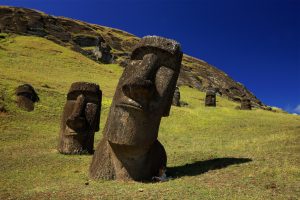
Easter Island is known to be most isolated island in the most distant sea. This beautiful island, and it’s around 900 moai statues, keep charming people from all around the world. Once you know the charm hidden in the misteries of this stonecarving civilization, you would understand why it is one of the most anticipated ports on our around the world voyages. We have asked Mr. Hideo Kataoka, our World Heritage Meister and someone who has a deep love for this island, to explain us the charms of this beautiful world heritage.
The unique tropical weather that surrounds this “big land”
Easter Island was received its name from Dutch explorer Jacob Roggeveen, as he arrived to this island on Easter Day in 1722. The locals refer to the island as “Rapa Nui” (Big Land). If we make a circle with a radio of 2,000 km centered in this island, we will be surprised by the few islands that you would be able to find. This is why, it is usually refered as the most isolated island in the world. On the other hand, this can also be interpreted as Rapa Nui having a vast sea around it. Is within this frame the Rapa Nui is considered to be a “big land”.
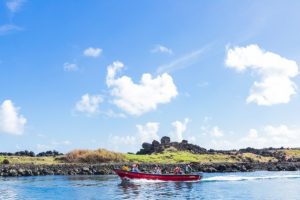
As there are no port facilities at Rapa Nui big enough to receive cruise ships, we must stop at an anchorage, using tender boats to bring people to land. While sitting on the tender boat you can feel the fresh sea breeze touching your cheeks, with waves splashing you from time to time after they crash against the boat. You can feel the excitement building up as we get closer to the island.
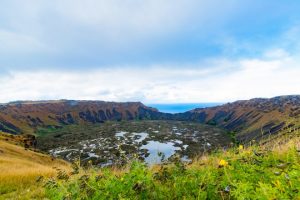
Easter Island is a volcanic island, made by the eruption of three maritime volcanoes. One of these volcanoes, the Rano Kau volcano, is located close to the sea and has one of the most magnificient views of the island.
The Moais as a symbol of the past
One of the reasons Easter Island became so famous is because of it’s moai statues. It is said that moais are representations of the ancestors and that they protect the villages. For this reason, most of the Moais face toward the inside of the island, with their backs facing to the sea. From all the existing Moai statues, only 45 of them are standing. The rest have been either toppled or disposed before completition. There are records that point out the existence of standing Moais when Jacob Roggeveen came in 1722. However, we know that about half of these moais were toopled down by the time Captain Cook visited this land 52 years later. What happened in Easter Island during those 50 years? To solve this mystery, we must note that all the toppled Moais were facing down.
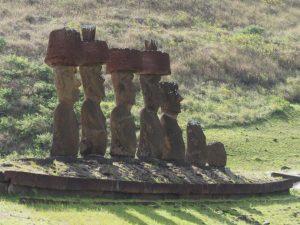
In Anakena Beach we can find 7 moais on the Ahu Nau Nau. Because they were buried in sand for a long time, their preservation state is very good. You can also see their Pukaos, red stones that may represent either a hat or hair.
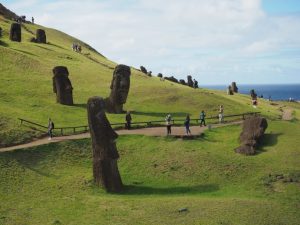
All the moais were made at a place called Rano Raraku. On the slopes of this mountain you can find many statues that have been buried up to the chest. Moreover, it is also the only place where you can see a moai being carved from a rock.
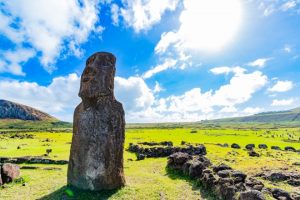
At a hill a little bit far from Rano Raraku you can see the Traveler Moai, a moai that came all the way to Japan for the Osaka Expo’70. As a Japanese person I feel a weird sense of familiarity with this moai from the simple fact that it has visited Japan.
A changing island and the climax of a civilization
Originally, this volcanic island was made purely of rocks, however vegetation started to flourish due to migratory birds bringinn seeds in their feathers, giving place to a forest after many years. As people started to inhabit this island, wood was needed and trees were cut down. Moreover, it is also thought that trunks were required in the elaboration and transportation of moais, resulting in a complete deforestation. Overexplotation of cultivated land became linked to a decrease of food production, causing food shortage and prompting conflicts between tribes. In order to demostrate power, many tribes started to produce moais in bigger quantities and sizes. As a retaliation, people started to topple these symbols of power. When a moai had it’s eyes placed, an spiritual energy called Mana would inhabit the Moai. People were afraid of this energy, explaining why they would make the moais face down in this moai-toppling wars.
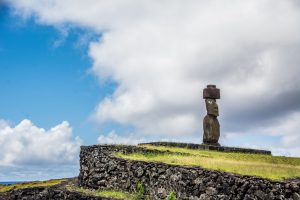
In the whole island there is only one moai that has eyes at Ahu Tahai, here you can see how the Moai was supposed to look originally and feel the spiritual power that islanders believed in.
Looking at the civilizations future from the eyes of a Moai
This civilization lasted for about a thousand years before collapsing down abruptly. According to some scholars, the reason behind this collapse is a that it became a runaway civilization. For example, computers and smartphones are very close to us in our daily lives, even if we tried to get rid of them and return to a lifestyle pre-computers, it would be imposible. Similarly, the people from Eastern Island were unable to think about reducing the size or numbers of the moais once after they had started producing them in big sizes and amounts. Reflecting on this point I may say that our society has a lot of common points. Even though we know that the earth environment is worsening and that global warming is accelerating, we still prefer convinience over sustainability. The moais are mementos from a forgotten civilization, statues that talk about the limitations of nature from this isolated island.
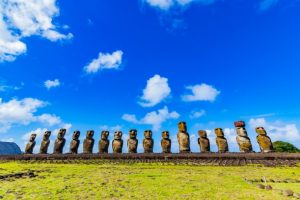
Ahu Tongariki has 15 moais on it. These moais that have seen the rise and fall of a civilization will keep watching the future of humanity and of this island.
